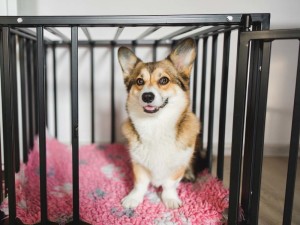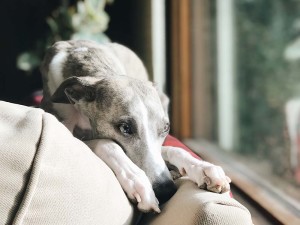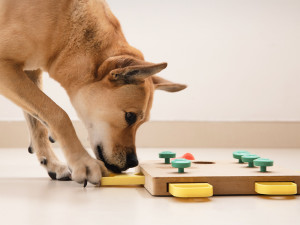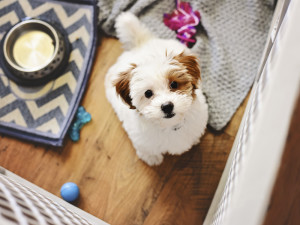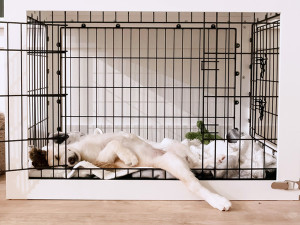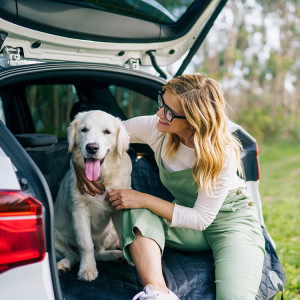How to Keep Your Dog Happy On Cage Rest
It doesn’t have to be all doom and gloom...
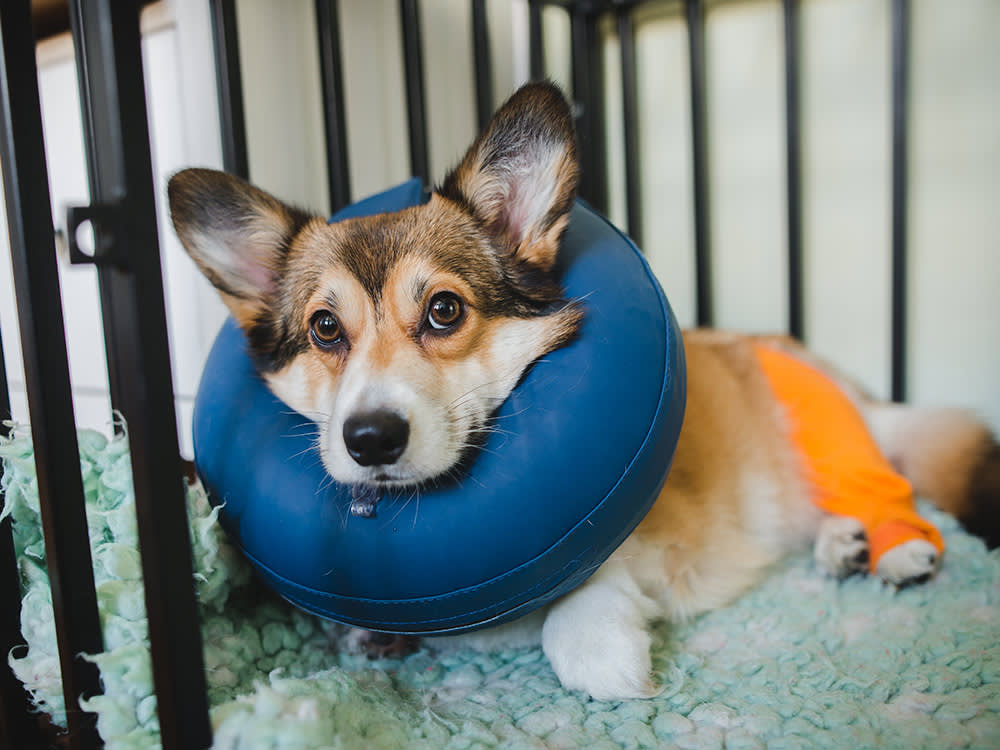
share article
Whether you have a new puppyopens in a new tab or a senior dogopens in a new tab, it is likely that at some point in your dog’s life, they will need to be placed in a crateopens in a new tab. This could either be for a short time because you’re in a new environment and you need to keep them safe, or for a prolonged time such as for prescribed rest and recuperation following an accident or surgery. As a registered veterinary nurse specialising in emergency and critical care, I often share tips with dog parents on how to make crate rest as stress free as possible for both you and your dog. Below, a breakdown of various methods that can be used to make the whole process more enjoyable... or even just bearable.
Create a positive association with the crate
Crates can often be viewed as a negative thing by dog parents, who think of them as a punishment space or prison for their pups, creating anxiety for both them and us. But this does not and should not to be the case. Crates can actually be a positive experience and a really useful tool for you and your dog. It is therefore really important that your dog views the crate as their safe place, and not as a punishment.
In order for your dog to feel safe and comfortable in their crate, you should start crate trainingopens in a new tab them early on in life, rather than waiting until the day when they absolutely have to use it, especially if that’s after they’ve already endured something stressful like surgery.
But if your dog is out of puppyhood, do not despair, introducing a crate at any stage in your dog’s life can be done as long as you take your time and follow these tips to make it as welcoming and comfortable as possible.
Feed them in the crate.
Only provide them with their high-value or special toy when in the crate.
Give your dog an item of your clothing with your scent on, which will provide comfort, or cover the top of the crate with a blanket to make it feel cosy.
Use the crate throughout the day for short periods of time and not just for bed time, which will also help associate the crate as a positive calming space, and you will likely find they will take themselves there when they need to rest (leave the door open for them so they can choose when to go in).
If these steps are taken to desensitise your dog to the crate when you first adopt them, it will also mean they will have a set place in your home that is theirs, which is vital to help them adjust to living in a busy family home – our pets sometimes just need a bit of alone time, too!
If your dog is on crate rest for an orthopaedic or neurological injury, make sure the area outside the crate is non-slip and that they can step out on to a grippy surface, such as a carpet or rug, to make getting them up and out for supervised toilet trips much easier and safer for everyone.
Use calming products
There are products available that can help your dog adjust to the crate environment, making it feel welcoming and calming.
Pheromones
Pheromone products that mimic the appeasing pheromones produced by a dog’s mother to calm her puppies can give your dog a sense of reassurance and belonging. This pheromone basically tells your dog that everything is alright. The pheromones are specific to dogs and will not have any effect on other animals or humans. They are available as collarsopens in a new tab, plug-in diffusersopens in a new tab or spraysopens in a new tab, depending on what will suit your dog the best.
Essential oils
There are also products that are a special blend of essential oilsopens in a new tab, which work with the body’s own natural calming mechanisms by mimicking a substance called GABA, the natural calming agent present in many species. This means in times of stress or anxiety, the essential oils help trick fired-up nerve cells into thinking they are getting a message from the brain to calm, which means they work instantly and can work on dogs as well as humans.
However, dog parents should first do some preliminary research and check with their vet to avoid any possible detrimental effects because many essential oils are toxic to dogs, including oil of cinnamon, citrus, pennyroyal, peppermint, pine, sweet birch, tea tree (melaleuca), wintergreen and ylang ylang. What may be safe for dogs can be fatal for cats and vice versa, while others are poisonous to both species.
Essential oils could be toxic to your dog if accidentally ingested or inhaled in too large a quantity – especially as their sense of smell is much more acute than ours. Ask your vet for more information. The Animal Poison Line also has a helpful listopens in a new tab of toxic and non-toxic plants for dogs.
There are other calming products available such as calming bed spraysopens in a new tab, room scentsopens in a new tab and reed diffusersopens in a new tab that can all help your dog to feel more relaxed when on cage rest. Your vet may also prescribe specific calming supplements and medications to help if they really are not coping with the enforced cage rest.
Keep your dog entertained
Cage rest doesn’t have to be boring, just because the vet has advised your dog to rest their muscles, it doesn’t mean they need to rest their brains! There are lots of interactive toysopens in a new tab and activities available that can provide stimulation and fun as well as rest. Many activities involve food, so it is important to make sure your pet doesn’t start to gain weightopens in a new tab as this will be detrimental to their recovery. It is therefore recommended that you use food from their daily allowance so they do not have any extra – simply their usual food given in an exciting way.
Stuffable toys, like Kongsopens in a new tab, provide excellent entertainment as they are robust and can be filled with different things to vary the difficulty level. Soft food items such as canned dog food can be placed inside to encourage plenty of licking; or use larger dry treats that can be wedged in to provide more of a challenge. They can also be frozenopens in a new tab, which will provide a way to keep your dog cool but also increase the difficulty. Fruit and vegetablesopens in a new tab can used or even soft cheese and dog-friendly peanut butteropens in a new tab – the options are endless! Just remember to count the calories.
There are also many types of puzzle feedersopens in a new tab available, that will help challenge your dog’s problem-solving skills. Many of these toys have different difficulty levels, which means you can increase the challenge as your dog gets the hang of them. Be careful to select the correct puzzle toy for the size of your dog, as some have small parts that could be accidentally swallowed in excitement.
Snuffle matsopens in a new tab are also a fantastic boredom buster, they are flat mats made with long strips of fabric tied to it that act like grass. Your dog needs to explore the mat with their nose to try and search out the treats amongst the fabric strips.
Lick matsopens in a new tab are rubber mats with raised patterns across them, which can be smeared with wet food, peanut butter, soft cheese etc, and dogs can use their tongue to clean it off. These can be especially useful if you need to keep your dog still for things like physiotherapy, bandage changes or ear cleaning, and some can even be stuck to walls.
Hopefully with these tips your dog will learn to love their crate as you make it safe, comfortable and entertaining. This will help make your dog’s recovery as smooth and stress free as it can possibly be!
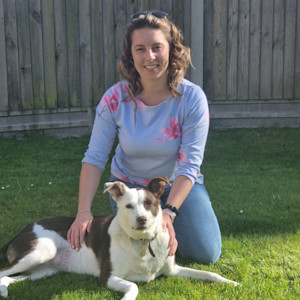
Samantha Bell BSc Cert VNECC RVN
Samantha is a registered veterinary nurse, specialising in emergency and critical care. She is passionate about neurology, working as the specialist neurology nurse at Queens Veterinary School Hospital in Cambridge. Outside of work, Samantha dotes on her pony Maggie and her Romanian rescue dog Eadee. Spending her time outside of the hospital, she enjoys the outdoors with Maggie and snuggles on the sofa with Eadee.
Related articles
![Smiling Welsh Corgi Pembroke dog sitting inside an open crate]() opens in a new tab
opens in a new tabHow to Crate Train a Puppy
Effective techniques to crate train your dog with ease
![A cute puppy looking up at the camera]() opens in a new tab
opens in a new tabWhen it Comes to Dog Crates, Think Outside The Literal Box
Dog behaviourist Tiffany Lovell on how to treat and prevent confinement anxiety
![white-and-black dog sleeping in crate]() opens in a new tab
opens in a new tabHow to Crate Train a Puppy at Night
It’ll make life easier for both of you – eventually
![A blonde woman wearing a longsleeved green jumper and sneakers sitting in the open trunk of a SUV car with her arm around her Golden Retriever dog sitting next to her]() opens in a new tab
opens in a new tabHow to Make Your Dog’s Car-Crate Anxiety a Thing of the Past
Celebrity dog trainer Victoria Stilwell explains how to crate train a dog with an intense fear of being in the car
![puppy jumping up on crate]() opens in a new tab
opens in a new tabGimme Shelter: The Best Dog Crates
Spend less time searching for your dog’s house than you do on Rightmove looking for yours
